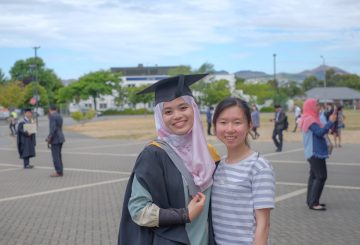ニュージーランドと中国は、先日閉幕したAPAC TVETフォーラムの傍ら、2日間にわたる中国・ニュージーランド高等職業教育サミットを開催し、アイデアやベストプラクティスの交換を通じて、高等職業教育分野でのパートナーシップを強化しました。
中国・ニュージーランドサミットは、特に高等職業教育における二国間パートナーシップに焦点を当てました。
「ニュージーランドと中国は、高等職業教育の分野で長年にわたって協力関係を築いてきました」と、Education New Zealand(ニュージーランド政府の留学促進機関)の国際部長Lisa Futschek氏は強調しました。
2月に開催されたニュージーランドと中国の第9回教育訓練合同ワーキンググループにおいて、ニュージーランドと中国は二国間のモデル職業教育プログラムについて話したとFutschek氏は指摘します。
高等職業教育における教育協力の9年目を迎えるにあたり、ニュージーランドが新たに設立した職業・応用教育の公的ネットワークであるテ・プケンガ(NZ Institute of Skills and Technology、NZ政府によって設立された高等教育機関)が、職業教育協力を前進させる主導的役割を担えることは喜ばしいことです。」
「我々のパートナーシップの強さは模範的であると認められ、その結果、APAC-TVETフォーラムの設立につながり、より広い地域の政府、機関、企業を結びつけ、我々の成功したパートナーシップを拡大することができました」と彼女は述べました。
中国教育部国際協力交流局の副局長であるXu Yongji氏は、参加者に対し、楽観的な見解を語りました。
「職業教育の全体的なレベルは世界の最前線に入り、技能社会の基本的な構築の主要な目標となっています。
「ニュージーランドは職業教育訓練において豊富な経験と先進的な考えを持ち、革新的な創造力を持ち、市場の需要に適応した多くの人材を育成しており、中国の職業教育訓練改革にとって理想的なパートナーです」と彼は述べています。
「今後、中国とニュージーランドの職業教育の交流と協力は、より緊密なものになるでしょう。
「中国とニュージーランドの社会経済発展のために、より質の高い職業技術者を育成するために、職業教育の特徴を強化し、生産と教育を統合するシステムを完成し、学校運営における学校と企業の協力メカニズムを革新し、職業教育指導の改革を深め、特別職業教育のブランドを構築するために、両国がより多くの協力を行うことが期待されます」とYongji氏は述べました。
「世の中で一番大切なものは何か、それは人、人、人です。」と、Te Pūkengaの子会社WINTECのSino-NZプログラムのディレクターTony O’Brien氏は語りました。
「この2つのセクターのコラボレーションには、システム、教育学、プロセスなどの議論が必要かもしれませんが、結局のところ、人、関係性に帰結するのです。」と彼は言います。
「現代経済では、頭と手の両方を使って仕事をすることが重要です。これからのイノベーターは、その両方に長けているはずです。この二面性、つまり考え、実行するというスキルは、「Learning by Doing」を奨励する教育システム、つまり学生が批判的かつ創造的に考え、挑戦し、探求する機会を持つことを奨励するシステムによって、最もよく伝授されるのです。教育機関は、指導者や教師を通じて、まさにこのような行動の模範となることが不可欠です。」
「そうすることで、ニュージーランドと中国が必要とする技術的、専門的な労働力を刺激し、生み出すことができます。これは、これは、Made in China 2025計画や第15次5カ年計画で明確に示され、ニュージーランド自身の改革でも暗黙のうちに示されています」とO’Brien氏は指摘しています。
Leon de W Fourie氏(インターナショナル・ワーキンググループ – テ・プケンガ議長)は、ニュージーランドの国際教育戦略2023-2028の草稿を紹介しました。
「テ・プケンガの設立は、国際教育セクター全体で統一された国際教育戦略を策定する機会を創出しました。テ・プケンガは、その規模とスケールで、優れた国際教育と世界とのつながりによって、学習者とニュージーランドに高い価値をもたらす未来を創造することに注力しています」と彼は強調します。
「テ・プケンガの設立により、強力で統一された持続可能な高等職業・応用高等教育システムが構築され、将来の仕事に適合し、学習者、雇用者、地域社会が繁栄するために必要なスキルを提供します。」
特に中国-NZの協力について言えば、ニュージーランドと中国の戦略的教育パートナーシップ協定の一部である中NZモデルプログラムのような国際プログラムは、現在のネットワークの国際的関与における卓越性とベストプラクティスの例であると示唆されました。
「私たちは、テ・プケンガを通じて、これらのプログラムを維持し、規模を拡大していく予定です。
「これまでの国際教育戦略策定において、中心的なテーマのひとつは、オフショアでの提供体制を強化することでした。現在のオフショアキャンパスを維持し、必要に応じて規模を拡大し、新しいキャンパスを設立する予定です。
Fourie氏は、テ・プケンガが「2022年半ばまでに1年から5年の移行計画を策定する」ことを、出席者に伝えました。
「2023年1月1日までに整備しなければならないものもありますが、国際教育のプロセスや活動によっては、移行にもっと時間がかかると思われます。」と締めくくりました。
情報元:PIE news






























































